About CPAP masks, what should I look out for to find the right one?
Constant Positive Airway Pressure (CPAP) ventilation has established itself as the treatment of choice for obstructive sleep apnea syndrome (OSAS). If set correctly, positive air pressure ventilation can cause a significant reduction in nightly breathing interruptions (sleep apnea) and reduce daytime fatigue. Treatment with CPAP devices can therefore be extremely effective – once you found the right mask from the huge assortment of cpap masks available on the market. An initial overview of available models can be found here: All CPAP masks.
CPAP masks transfer the air pressure from the CPAP device to the user’s airways. It thus represents the interface between man and machine. And this interface is facilitated by a foreign body, which rests on the face, which many people, however,find difficult to get used to at first. Therefore, it is all the more important that the mask fits comfortably and seals properly so that wearing it does not add to the difficulty of the situation.
Thus, CPAP masks play a central role for the patient in their acceptance of CPAP therapy and thus also for it’s therapeutic success. If the mask does not fit properly from the start and causes pressure points, the user will, in many cases, not be able to get used to this foreign body at all. This can lead to the situation that CPAP ventilation is only used irregularly or is even completely abandoned. This is a shame, because positive pressure ventilation is actually a promising and effective therapy for sleep apnea syndrome and would help the affected person!
This also explains why about 30-40% of all CPAP patients stop their therapy sooner or later or at least do not wear their device every night – which is a serious mistake, because in order to be effective, CPAP therapy has to be used every night.
It is therefore extremely important to find the mask that suits you best. This is the best way to avoid being frustrated by your mask and finally giving up on CPAP therapy and thus suffering the consequences of obstructive sleep apnea.
What are the technical requirements for CPAP masks?
Undisturbed air flow in the mask
From a technical point of view, the most important thing with mask ventilation is that the air flow is not disturbed. Because, if the air cannot flow properly through the mask, the pressure in the CPAP device can still be optimally adjusted – but not much of the excess pressure will arrive in the airways. This means that the therapeutic effect can be partially or completely lost, i.e. CPAP ventilation does not work as desired.
Expiratory valve
In addition, the mask must enable trouble-free exhalation. For this purpose, all masks commonly used today have a built-in valve through which the carbon dioxide (CO2) in the exhaled air can flow when exhaling. If this does not work properly, you will inhale the carbon dioxide you have just exhaled, the next time you breathe in. This reduces the oxygen content in the air you breathe, and oxygen is very important for a restful sleep, especially for people with OSAS.
Comfortable material
The material of the mask is also important. Especially the plastic seal / cushion, which is in direct contact with the skin of the face, should be made of durable material. Otherwise it wears off and there are places where the air can escape. In addition, the material should be tolerated as well as possible by the skin and be pleasantly soft in order to avoid pressure points and irritations.
The correct fit of the mask – what should I pay attention to?
In addition to the technical requirements (which almost all of today’s masks meet, anyway), the correct fit of the mask is essential for the well-being of the user. Especially in the beginning, sleeping with a plastic mask on your face is very unusual. A good fit and comfortable material can make this phase much easier for the wearer and make an important contribution to ensuring that they continue with the therapy. In addition, here is some important information:
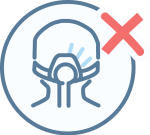
Sealing of the airways
The mask should sit comfortably on the face and seal the airways well. If the fit is too loose, air can escape out of the mask. This typically leads to two problems. Firstly, part of the therapeutic pressure built up by the CPAP device is lost, i.e. the air pressure breathed in is lower than it should be. On the other hand, air leakage can cause eye irritation if the leak is on the bridge of the nose or on the upper side of the cheeks. This is because an air current flows through the leak towards the eyes and can irritate the eyes, or the the tear ducts in the eyes. An optimal fit of the mask prevents this and also prevents it from slipping during sleep.
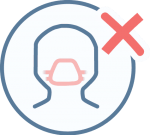
Not too tight
At least as important as tightly closing the mask on the face is that the mask is not too tight. This can lead to discomfort and, if the mask is used for a long time, can cause painful redness and pressure sores.
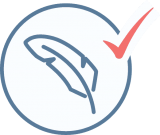
Not too heavy
The mask should also be light so that it is not too annoying to wear at night. Even a few grams of difference in weight can determine whether a mask is comfortable or uncomfortable when worn for hours during the night.
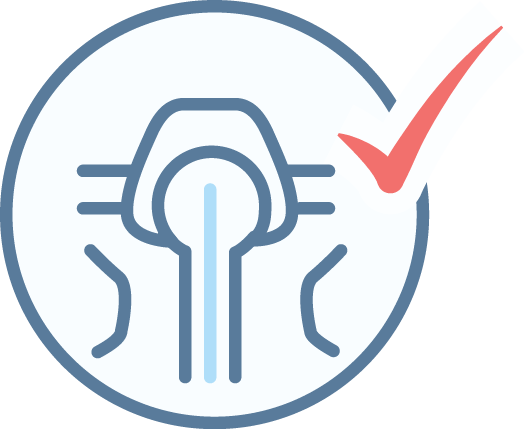
Undisturbed airflow
Finally, the air flow in the mask should flow well. Although all CPAP devices generate sound, these sounds are usually not as annoying as the flow noises that arise when air flows through the mask and encounters obstacles. If the mask is too small, the air does not have enough space. This causes turbulence in the air stream, which leads to noises in the mask.
How is a CPAP mask structured?
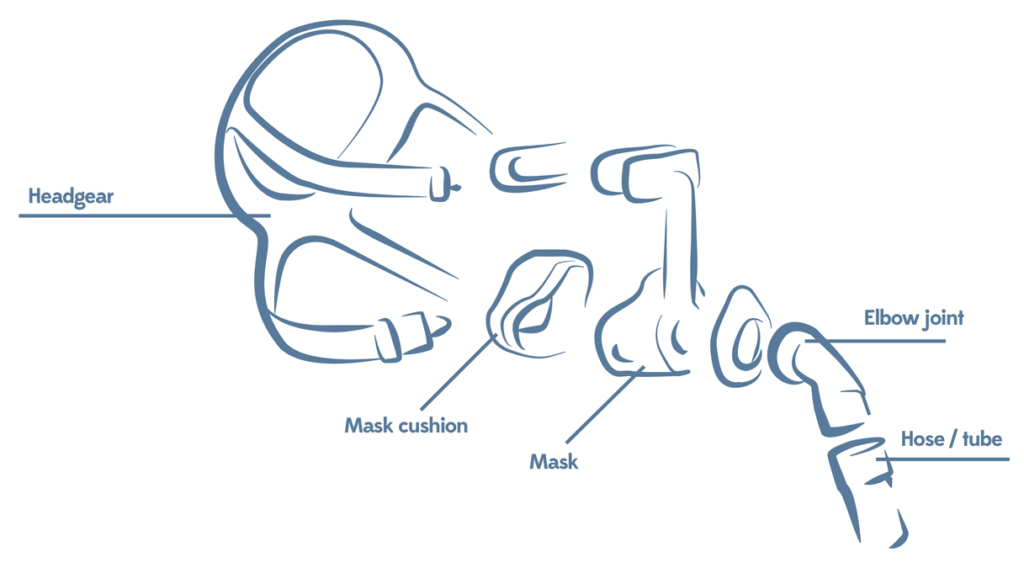
The different CPAP masks differ in their design (the different mask types will be introduced below), but some basic elements are present in all masks:
Hose
CPAP masks are connected to the CPAP device via a tube. For this purpose, the masks are equipped with a connecting piece that attaches the tube to the mask. Usually the whole thing is secured with a retaining ring so that the tube does not fall off during sleep.
Elbow joint
Between the tube and the mask there is often a an angled piece. This is a bent plastic tube or elbow joint. This should prevent force transmission from the hose to the mask, i.e. the hose should not “pull” at the mask. This prevents the mask from moving so easily when you are asleep.
Mask
The actual mask usually consists of hard plastic, the shape of which differs depending on the type of mask. The mask usually also incorporates the valve through which the exhaled air can flow without the pressure escaping from the CPAP device.
Mask cushion
The seal / cushion is the connecting piece between the mask and the face of the wearer. The seal / cushion of the mask rests on the face of the wearer. It is usually made of soft plastic or silicone so that the cushion adapts well to the contours of the face and exerts as little pressure as possible on the skin.
Moistening system
To prevent the mucous membranes from drying out during CPAP ventilation, it is important that the air contains sufficient moisture. Some devices already have a humidification system installed for this purpose. If this is not the case, there are small humidifiers that can be connected between the tube and the mask to ensure that the mucous membranes are supplied with sufficient moisture.
Headgear
CPAP masks are attached to the head with several adjustable straps so that it fits snugly, but firmly to the face. These should be adjusted so that the mask is neither too tight nor too loose on the face.
Accessories
As an additional accessory for nose masks, a so-called chin strap is often recommended. This is intended for people who often unconsciously breathe through the mouth while asleep. The chin strap prevents the mouth from opening during sleep and thus prevents air from leaking out of the mouth. Alternatively, mouth breathing and thus mouth air leakage can also be prevented by using a snoring mouth guard.
What different types of CPAP masks are there?
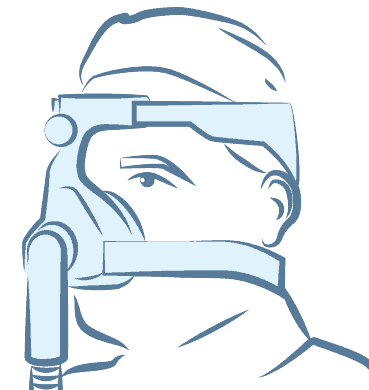
Nasal CPAP Masks
Nasal masks are the most commonly used CPAP masks and accordingly there is a wide range of products from various manufacturers. If a patient has no special requirements and tolerates this type of mask well, a nasal mask is usually recommended. In fact, it actually represents the standard mask type.
The seal of this mask only surrounds the nose and should of course seal tightly, otherwise air leaks can cause eye irritation. It is usually made of silicone, but there are also masks with a gel seal. In addition, most models have a forehead support made of plastic, which is padded with foam or rubber. It should stabilise the mask during use, but must not press too firmly on the forehead, otherwise pressure points can also develop here. A nasal mask should always be used together with a humidifying system. It warms and moistens the inhaled air and prevents the nasal mucous membranes from drying out or becoming irritated.
Nasal masks are suitable for most people with OSAS. However, if you often breathe through your mouth while asleep, these masks are less suitable because air will leak out of your mouth. The result is dry mucous membranes and ineffective ventilation pressure. In addition, nasal masks can also result in air leaks at the bridge of the nose. The air then partly flows over the eyes and can irritate the eyes as well as the tear ducts in the eyes.
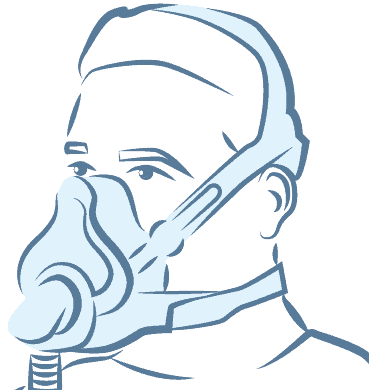
Minimal Contact Full Face CPAP Masks
This type of mask covers both the mouth and nose but is less obtrusive. The fact that it covers both the nose and the mouth is an advantage for people who often unconsciously breathe through the mouth at night and struggle with the problem of air leaking out of their mouth. Since the masks also cover the mouth, it is easy to breathe through the mouth while the necessary air pressure still reaches the airways. Therefore such a mask can also be used as a temporary solution if one suffers from a blocked nose during the course of a cold or allergy and nasal breathing is difficult. In addition, a well-adapted minimal contact full face mask usually works well even when particularly high CPAP pressures are required.
Although the minimal contact full face mask is slightly larger than the smaller nasal mask, they are usually quite well tolerated by users. However, they are more difficult to adjust, as not only the nose, but also the mouth must be sealed. People with beards, in particular, sometimes have problems here, as the facial hair can cause leakages on the underside of the mask. The main criticism of minimal contact full face masks is that one may tend to experience a sense of claustrophobia as the mouth and nose are covered at the same time. However, all masks have a built-in emergency breathing valve so that breathing is possible even if the CPAP device should fail.
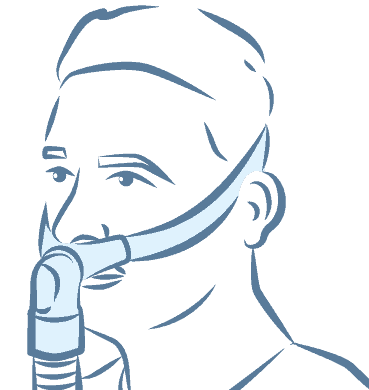
Nasal Pillow CPAP Masks
Nasal pillow masks consist of two olive-shaped air outlets that are placed in the nostrils and fastened under the nose. This eliminates the need for a seal, as is the case with other masks. Their advantage is that they distribute the air pressure directly into the nostrils. This type of mask is therefore particularly suitable for people who cannot cope with a larger mask because they suffer from choking sensations or anxiety attacks. The masks are very light and offer the greatest “facial freedom”.
However, the tubes to the nasal olive masks are also much narrower than those of conventional masks. Therefore, the airflow is delivered to the airways at a much higher speed in order to build up the necessary pressure. This can be perceived as disturbing. If you require high pressures CPAP ventilation, a nasal cushion mask is not particularly suitable for you.
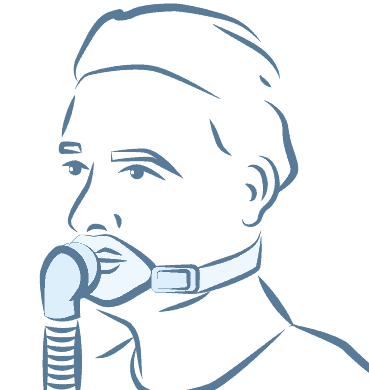
Mouth CPAP Masks
Mouth masks, i.e. masks that only cover the mouth, are very rarely used. They may be necessary as an alternative if a patient cannot breathe through the nose due to an injury or facial malformation. Or if special care must be taken after nasal surgery, then a mouth mask can be a sensible temporary solution. However, they are hardly suitable as a permanent solution.
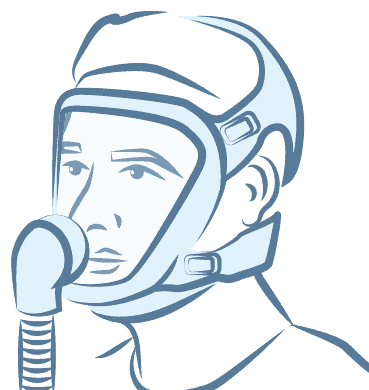
Full Face CPAP Masks
This special type of mask looks like the breathing masks that firefighters wear on their missions. The whole face is covered by the mask. They are only necessary in special situations, for example when facial deformities, dentures or heavy facial hair mean that no other mask is suitable. The whole face is enclosed, but since mouth and nose are not in direct contact with a seal under the mask, the full-face models are also suitable for claustrophobic people. There are even customised, made-to-measure models if you want and need an individually tailored mask. Pressure sores are less common and air leakage from the mouth is prevented. However, it can result in eye irritations, since the eyes are located within the mask and the air permanently flows around the eyes.
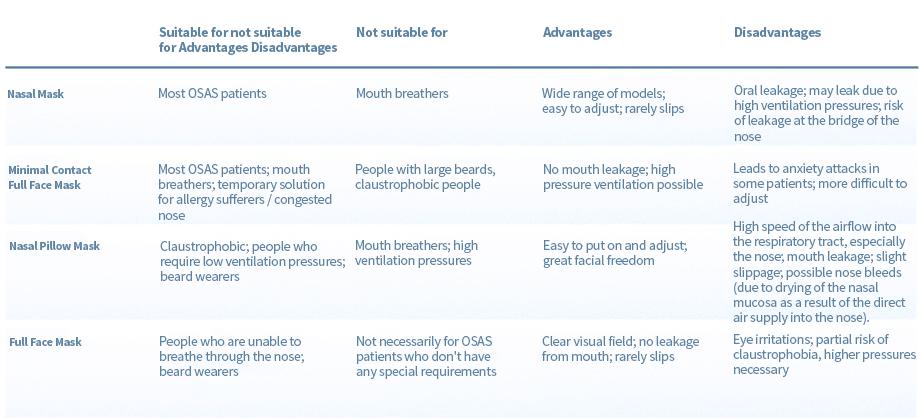
How to choose the right mask – Tips for buying a mask

Take your time
Take enough time to try out different mask types and sizes. Choose the mask that best suits you.

Measure your face
In order to determine the correct mask size, face templates are available from the various manufacturers. These are placed on the face and show which size suits you best.

Test the mask on the connected device
You can only judge whether the mask fits correctly if you are lying down and have connected the CPAP device. If you have decided on a mask, you should also test it with the CPAP device connected and switched on. The best thing to do is to lie down. This is the only way to determine whether the mask is uncomfortable for you or whether there are air leaks and whether you can tolerate the weight of the mask well or not.

Let your breathing habit decide
The choice of mask type depends primarily on how you breathe. Can you breathe easily through your nose? Then a pure nasal mask is the right choice for you. Or are you more of a mouth breather? Then a minimal contact full face mask or a full face mask would make more sense.

Have the mask tested in the sleep lab.
If possible, the mask should be tested overnight under controlled conditions in a sleep laboratory. In many cases this will not be possible, but in the laboratory there would be an unquestionable possibility to check that you have sufficient air pressure and to measure whether the apnea episodes are effectively prevented during sleep.
Welche Nachteile und Probleme es mit der CPAP-Maske geben kann und In our article on side effects of CPAP therapy you can read about the problems and disadvantages that can be associated with CPAP masks and how to deal with them.
This unique CPAP mask test compares the most popular masks on the market
The most important purchasing criterion for mask wearers; comfort, freedom of movement and far more, coherently summarised especially for you.
What Are the Alternatives to Sleep Apnoea Masks?
Do you suffer from side effects as a result of wearing a sleep apnoea mask? In this article we inform you of alternative therapeutic options available to treat your sleep apnoea.
Best Ways to Clean Your CPAP Mask and Machine
Want to keep your CPAP equipment working better for longer? Discover our best tips to keep your CPAP mask and machine fresh, clean, and healthy for you.

Medical Doctor, Berlin
Jan Wrede works as a medical doctor in Berlin. He studied medicine at FAU University in Erlangen-Nuremberg and Semmelweis University in Budapest. He had already written numerous scientific articles during his studies, especially on the subject of snoring.


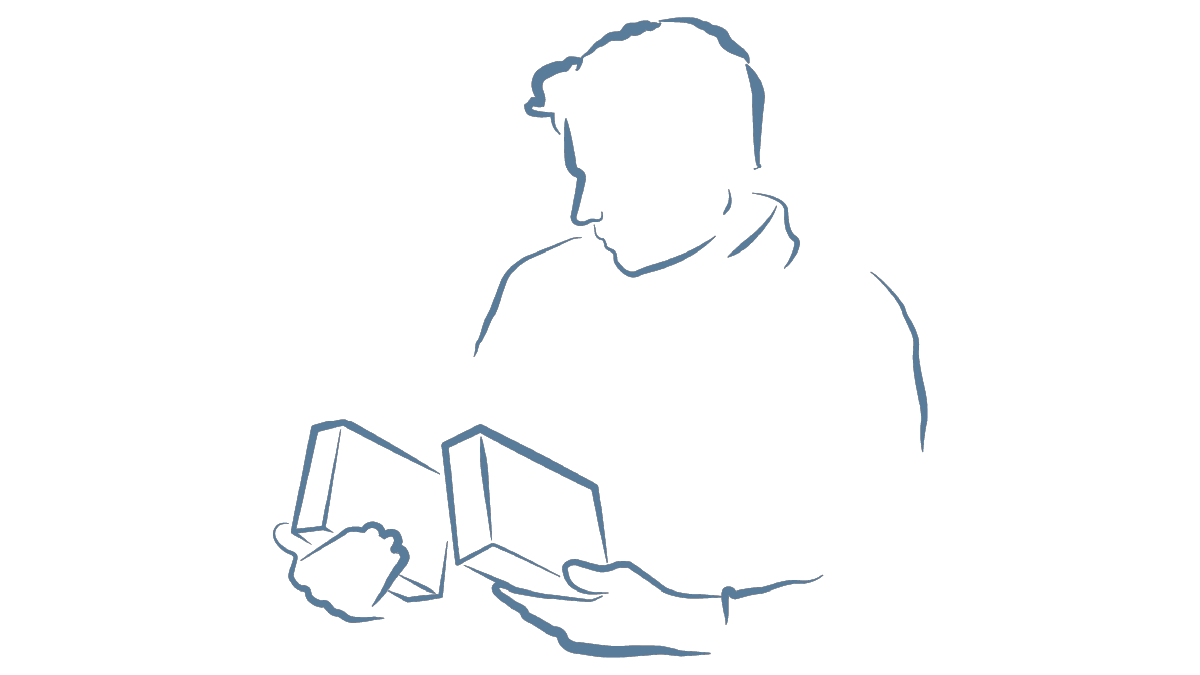

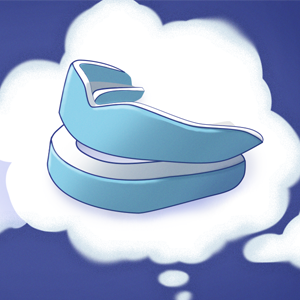

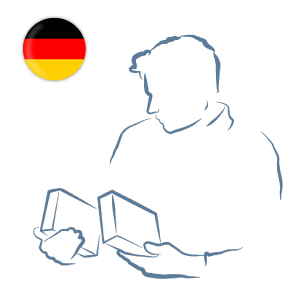
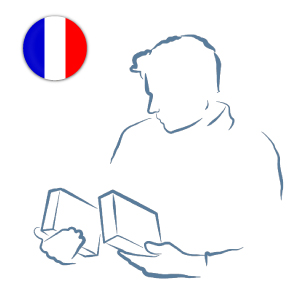
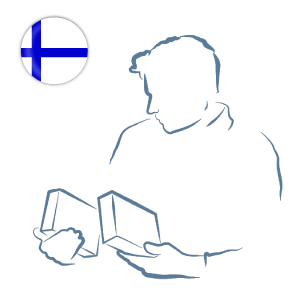
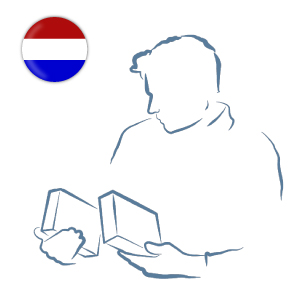


 Welcome to SomniShop
Welcome to SomniShop